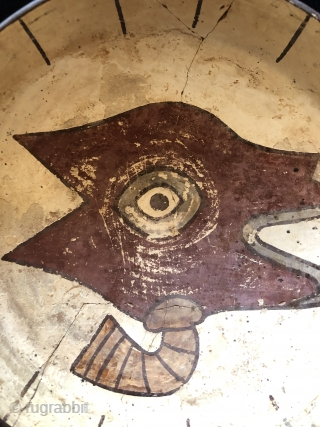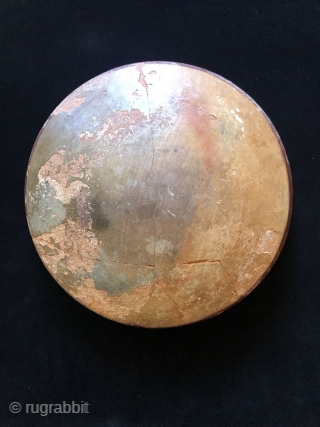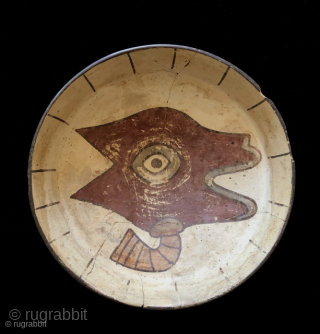Back
Pre-Columbian shallow bowl with stylized llama head on ivory colored background. Nasca Culture, Peru. ad. 200 to 600. Size: 10 inches in diameter x 3 inches deep. The Llama head on this bowl is depicted in profile tethered to a rope. For pre-Columbian Andean cultures llamas represented wealth and fertility and were considered sacred. Llamas were vital for trade as pack animals able to carry up to 90 pounds on their backs through the Andes with the additional advantage of being able to graze for their own food along the route. Llamas provided nearly all of life's essentials, meat, hides and wool for textiles and clothing as well as dung for soil enrichment of the fields. They played an important role in many rituals and sacrifices and were regularly sacrificed as gifts to the gods. Many myths and legends abound concerning llamas. The most important dark cloud constellation in the Andes region was called Yacana (Llama) and was thought to depict a mother and daughter pair. The two brightest stars of Yacana were said to represent the eyes of the mother llama and are found in the constellation we call Centaurus. For the herders of the Andes these animals were considered almost like family members. They were selectively bred to produce the desired qualities necessary for the survival of the indigenous peoples of this harsh, high altitude environment.
price:
SOLD - Thank you
- Home
- Antique Rugs by Region
- Category
- Profiles
- Post Items Free
- Albums
- Benaki Museum of Islamic Art
- Budapest: Ottoman Carpets
- Gulbenkian Museum
- Islamic Carpets. Brooklyn
- Islamic Textiles. Brooklyn
- Konya Museum: Rugs
- MKG, Hamburg
- MMA: Caucasian Carpets
- MMA: Mamluk Carpets
- MMA: Mughal Indian Carpets
- MMA: Ottoman Carpets
- MMA: Safavid Persian Carpets
- MMA: Turkmen Rugs
- McCoy Jones Kilims
- Ottoman textiles. Met
- Philadelphia Museum
- Rugs and Carpets: Berlin
- Seljuqs at the Met
- TIEM, Istanbul: Carpets
- V&A: Classical Carpets
- Vakiflar Carpets: Istanbul
- Baluch Rugs: Indianapolis
- Gallery Exhibitions
- Jaf an Exhibition
- Alberto Levi Gallery
- Andean Textile
- Christie's London: 2016
- Francesca Galloway
- HALI at 40
- ICOC Washington, DC 2018
- Jajims of the Shahsavan
- London Islamic Week April, 2018
- Mongolian Felts
- Navajo Rugs: JB Moore
- Persian Piled Weavings
- SF Tribal & Textile Art Show 2020
- SF Tribal 2019
- Sotheby's: C. Alexander
- Turkish Prayer Rugs
- Turkmen Main Carpets ICOC 2007














